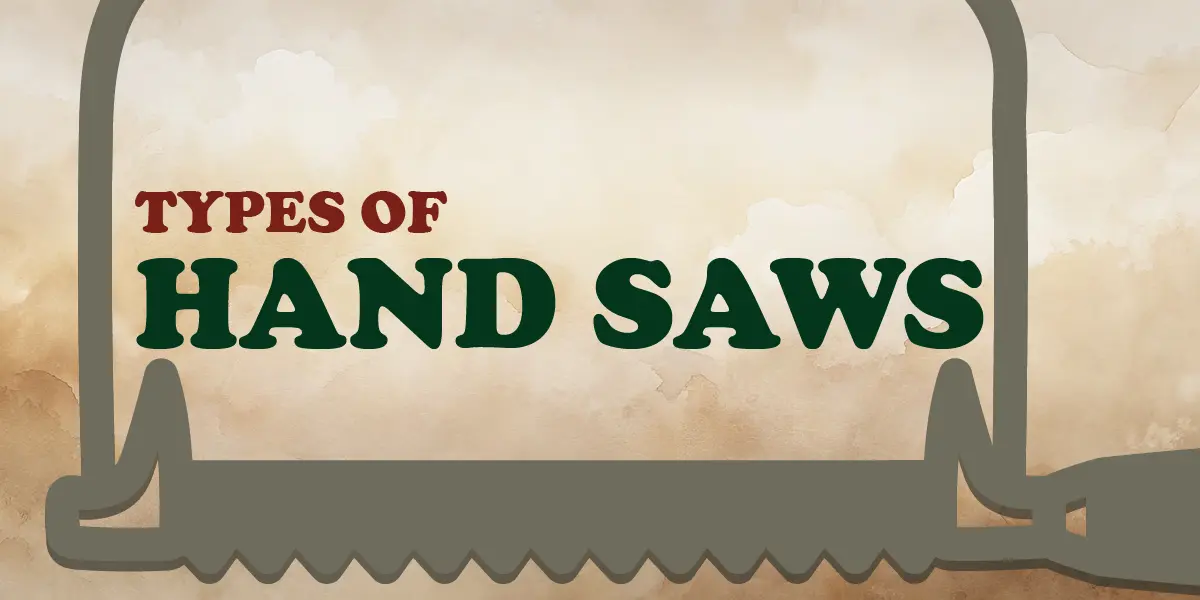How does a hand saw stay in shape?
Crossfit… crosscut, ripcut, repeat. (Drum crash, please: ba-dum-tss!)
Bad jokes aside, woodworkers, carpenters, and DIY devotees take their saws seriously and always choose the right tool for the job.
A panel saw works poorly for tree trimming; a crosscut saw will never do for dovetail joints and fine woodworking.
Different saws are designed for different tasks, and the appropriate one can save time, enhance precision, and make your work much easier.
This guide highlights a range of hand saws, their uses, and how they can improve your woodworking, metalworking, and landscaping efficiency.
Woodworking Saws
1. Crosscut Saw
Use: Cutting across the wood grain.
Key Features
- Sharp teeth that create clean cuts through wood fibers.
- Ideal for general-purpose carpentry and cutting lumber.
Best For: Breaking down boards, trimming wooden planks, and framing.

A crosscut saw cuts across the wood grain of a board.
2. Rip Saw
Use: Cutting along the wood grain.
Key Features
- Fewer teeth per inch for faster cutting with the grain.
- Aggressive cutting action ensures efficient wood removal.
Best For: Long, straight cuts in boards or rough lumber.
3. Back Saw
Use: Precision cuts in wood. Often paired with a miter box.
Key Features
- A reinforced spine for added stability and precise control.
- Fine-toothed 5030 blade for clean, accurate cuts.
Best For: Miter cuts, tenon joints, and other intricate joinery tasks.
4. Panel Saw
Use: General-purpose woodworking.
Key Features
- Shorter than traditional hand saws.
- Can manage various cuts, especially in smaller spaces.
Best For: A go-to saw for hobbyists and smaller projects.
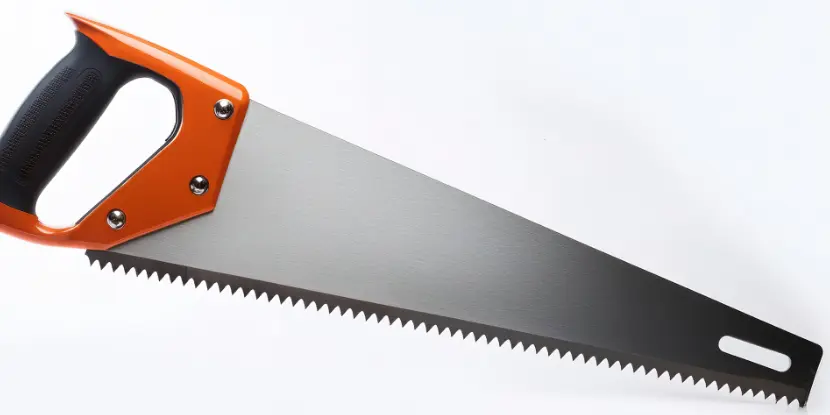
A panel saw is shorter than traditional crosscut saws and can work in tighter spaces.
5. Japanese Pull Saw (Ryoba)
Use: Precision cuts on the pull stroke.
Key Features
- Thin, flexible blade that cuts cleaner and faster than push saws.
- Dual-edged for versatility (crosscut and ripcut on the same blade).
Best For: Fine woodworking and precise details.
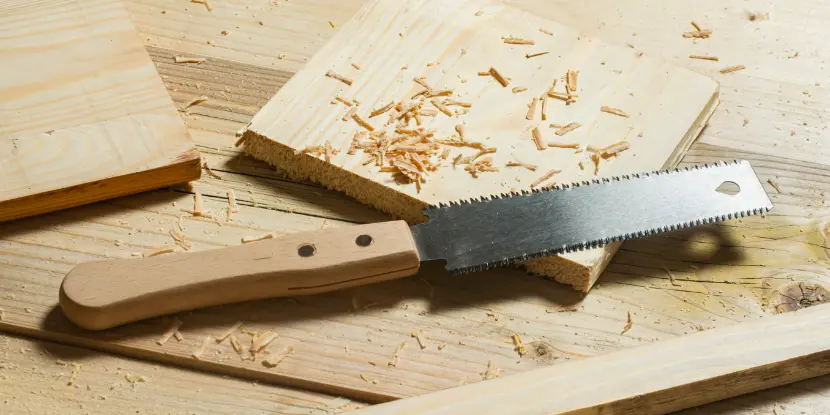
A Japanese pull saw makes precision cuts on the pull stroke.
6. Flush-Cut Saw
Use: Trimming dowels or plugs flush to a surface.
Key Features
- Flexible blade with fine teeth.
- Cuts parallel to surfaces without damage.
Best For: Finishing and detail work in wood projects.
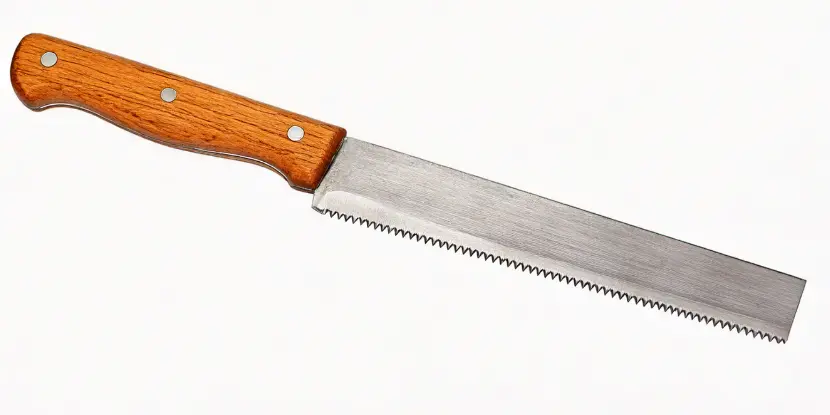
A flush-cut saw trims dowels or plugs flush to a surface.
7. Tenon Saw
Use: Creating tenon joints.
Key Features
- Looks similar to a back saw.
- Make fine-toothed for smooth, exact cuts.
Best For: Precise joinery in furniture making.
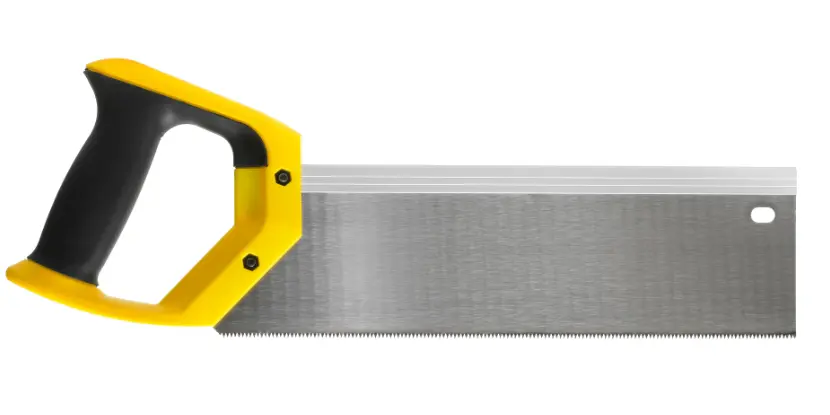
A tenon saw is used for precise joinery in furniture making.
8. Dovetail Saw
Use: Cutting dovetail joints.
Key Features
- Very fine teeth for delicate cuts.
- Lightweight and easy to control.
Best For: Intricate joinery like dovetail connections in cabinets and boxes.
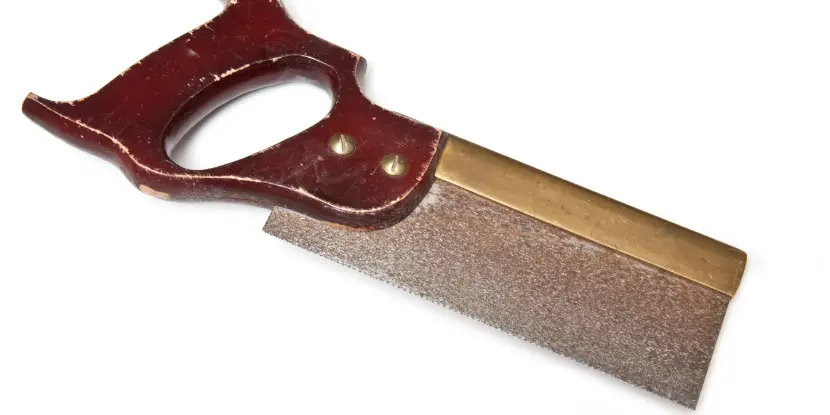
This old dovetail saw has seen many years of service.
9. Carcass Saw
Use: Precision joinery work.
Key Features
- Slightly larger than a dovetail saw, but smaller than a tenon saw.
- Fine teeth for clean cuts.
Best For: Cutting across or along wood grain in detailed projects.
10. Veneer Saw
Use: Cutting thin sheets of veneer.
Key Features
- Compact design with a fine-toothed blade.
- Provides clean cuts without splitting delicate materials.
Best For: Veneer and laminate work.
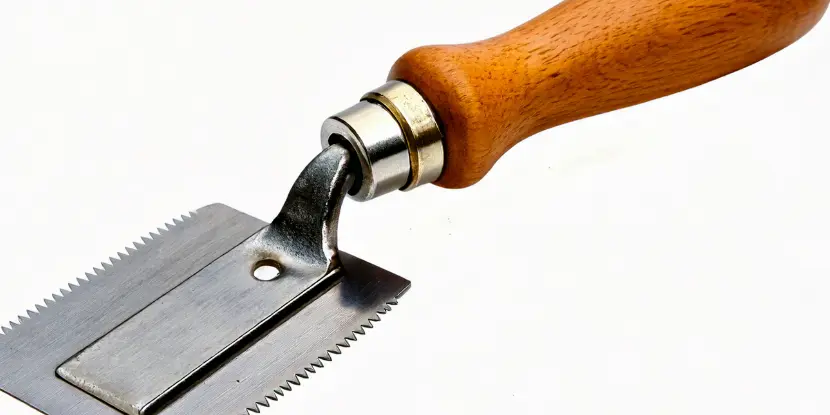
A veneer saw provides clean cuts without splitting delicate materials.
Specialty Saws
11. Coping Saw
Use: Cutting intricate curves and interior shapes.
Key Features
- Thin, replaceable blade mounted on a U-shaped frame.
- Excellent for fine woodworking and molding.
Best For: Detailing and trim work.

A coping saw cuts intricate curves and interior shapes.
12. Fret Saw
Use: Detailed, scroll-like cuts.
Key Features
- Extremely thin blades for tight, intricate curves.
- Similar to a coping saw but with a deeper frame for larger projects.
Best For: Decorative and scrollwork in woodworking.
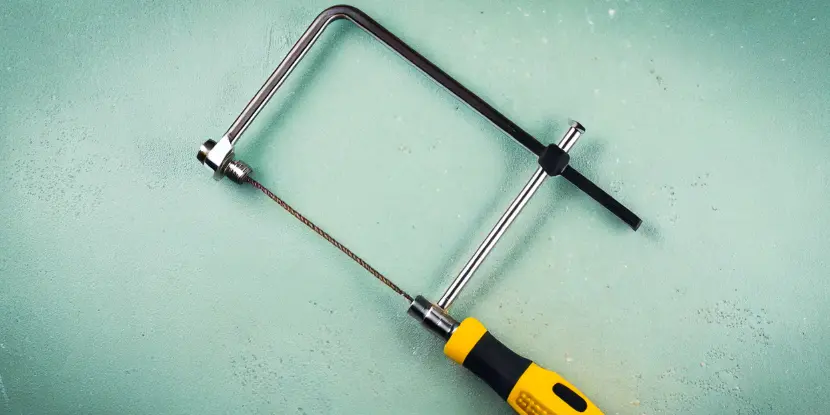
A fret saw is similar to a coping saw but with a deeper frame and a thinner blade.
13. Hacksaw
Use: Cutting metal, plastic, and pipes.
Key Features
- Strong frame with a replaceable, fine-toothed blade.
- Designed for tough materials.
Best For: Metalworking and plumbing cuts.
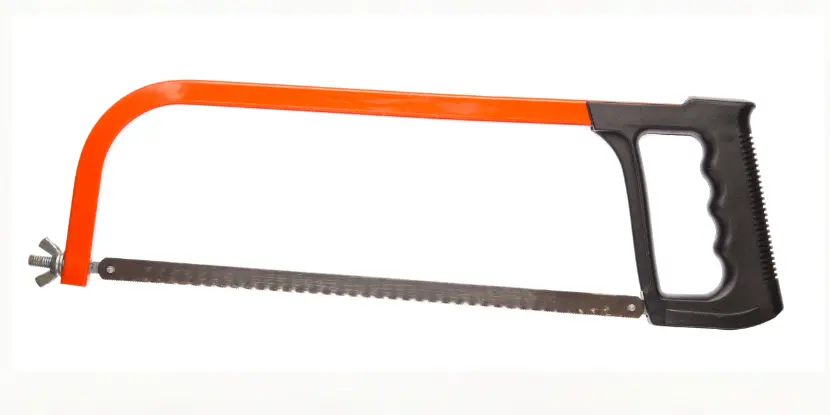
Did you wake up in leg irons? A hacksaw is what you need.
14. Bow Saw
Use: Rough cuts in larger wooden pieces and green wood.
Key Features
- Large, sturdy frame for increased leverage.
- Aggressive teeth ideal for outdoor work.
Best For: Cutting tree limbs, logs, and other heavy-duty tasks.

A bow saw is most effective for cutting rough or green wood, such as tree branches.
15. Keyhole (Compass) Saw
Use: Cutting holes and curves in drywall or wood.
Key Features
- Long, pointed blade that tapers to a thin tip.
- Ideal for confined spaces.
Best For: Freehand work, such as cutting out shapes or drywall patches.
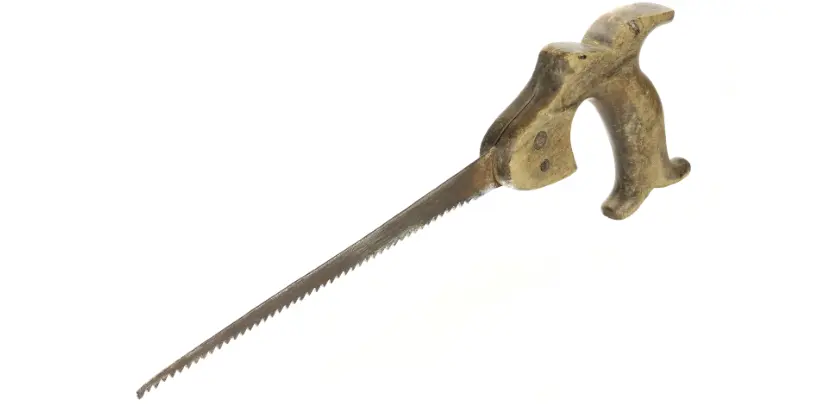
This vintage keyhole saw has seen better days.
16. Pruning Saw
Use: Trimming trees and shrubs.
Key Features
- Curved or straight blade with coarse teeth.
- Some models can be folded for easy storage.
Best For: Pruning green, living branches and limbs.
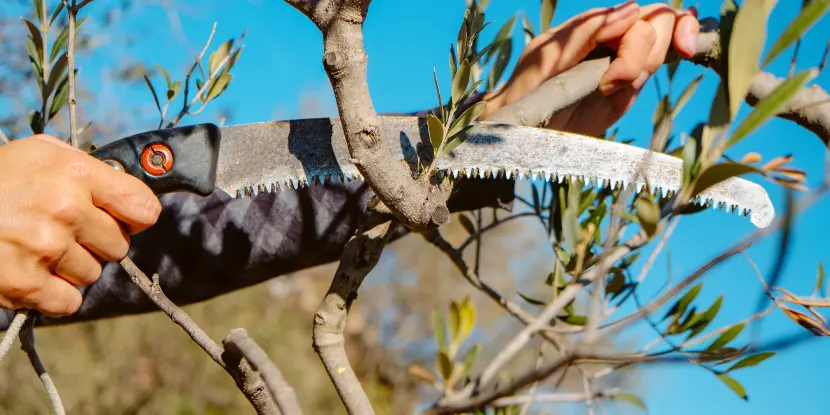
A gardener uses a pruning saw to trim branches.
17. Pole Saw
Use: Reaching high branches for pruning.
Key Features
- Pruning saw attached to a long handle (manual or powered).
- Reaches extended heights safely from the ground.
Best For: Landscaping and maintaining tall trees.
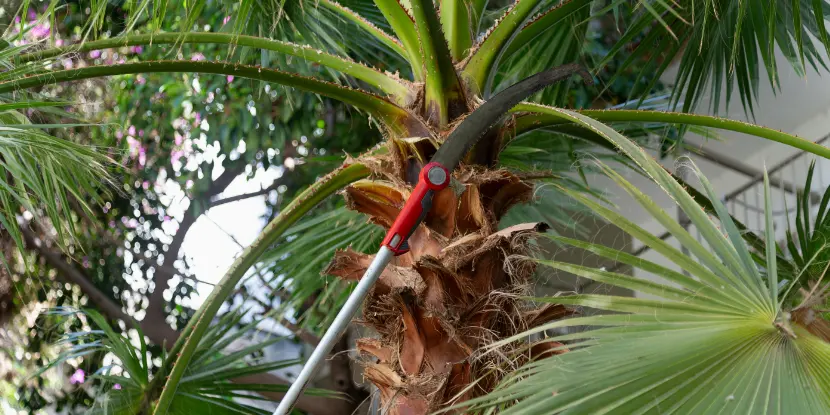
A pole saw in action. How else are you going to reach those fronds?
18. Drywall Saw
Use: Cutting into drywall.
Key Features
- Pointed tip for punching holes.
- Coarse teeth made for sawing drywall cleanly.
Best For: Installing electrical boxes or fitting drywall pieces.
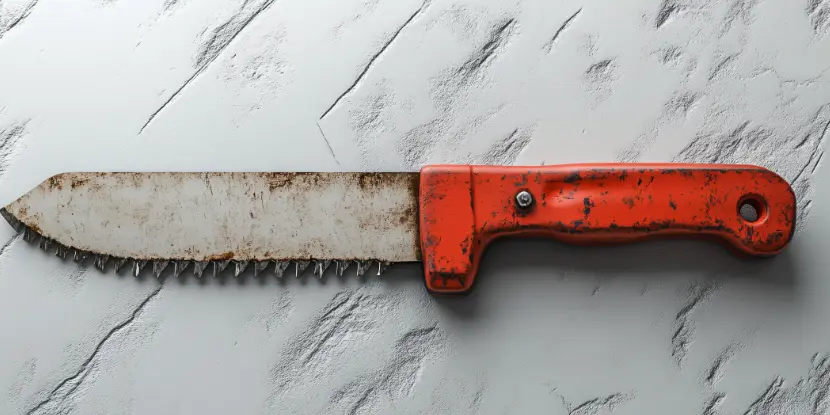
This drywall saw is getting long in the tooth, so to speak.
19. Wallboard Saw
Use: Cutting wallboard or drywall.
Key Features
- Short, coarse-toothed blade for quick cuts.
- Durable design tailored for construction tasks.
Best For: Versatile drywall cuts.
20. Razor Saw
Use: Fine detail work in modeling, woodworking, and other crafts.
Key Features
- Extremely thin blade with extra fine teeth.
- Allows for precise cuts in tight spaces.
Best For: Cutting plastic, wood, or metal without damaging delicate parts.

This drywall saw is getting long in the tooth, so to speak.
FAQs: Types of Handsaws
Q: What’s the most versatile hand saw for beginners?
A good place to start is a panel or crosscut saw. Both are suitable for general-purpose woodworking.
Q: What’s the difference between a rip saw and a crosscut saw?
Rip saws cut along the wood grain, while crosscut saws cut across the wood grain.
Q: Can a hacksaw cut wood?
Yes, but why? A hacksaw is designed to cut harder materials like metal and plastic and is inefficient for cutting wood.
Q: What’s the best hand saw for fine woodworking?
Japanese pull saws or a dovetail saw are excellent for precision and detailed work.
Q: Which hand saw is ideal for cutting curves?
A coping or fret saw works best for intricate curves and detailed cuts.
Q: How do I maintain my hand saws?
Keep the blades clean and dry, store them in a protected space, and sharpen regularly if applicable.
Q: Are bow saws only for outdoor use?
Not necessarily, but they’re most effective for cutting rough or green wood, such as tree branches.
Q: What’s the best saw for pruning high branches?
A pole saw gets the job done safely and efficiently.

